Active and passive properties of canine abduction/adduction laryngeal muscles
- PMID: 16102663
- PMCID: PMC1552101
- DOI: 10.1016/j.jvoice.2004.04.005
Active and passive properties of canine abduction/adduction laryngeal muscles
Abstract
Active and passive characteristics of the canine adductor- abductor muscles were investigated through a series of experiments conducted in vitro. Samples of canine posterior cricoarytenoid muscle (PCA), lateral cricoarytenoid muscle (LCA), and interarytenoid muscle (IA) were dissected from dog larynges excised a few minutes before death and kept in Krebs-Ringer solution at a temperature of 37 degrees C +/- 1 degree C and a pH of 7.4 +/- 0.05. Active twitch and tetanic force was obtained in an isometric condition by applying field stimulation to the muscle samples through a pair of parallel-plate platinum electrodes. Force and elongation of the samples were obtained electronically with a dual-servo system (ergometer). The results indicate that the twitch contraction times of the three muscles are very similar, with the average of 32 +/- 1.9 ms for PCA, 29 +/- 1.6 ms for LCA, and 32 +/- 2.4 ms for IA across all elongations. Thus, PCA, LCA, and IA muscles are all faster than the cricothyroid (CT) muscles but slower than the thyroarytenoid (TA) muscles. The tetanic force response times of these muscles are also similar, with a maximum rate of force increase of 0.14 N/ms.
Figures

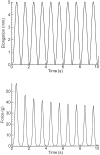

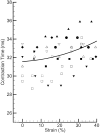
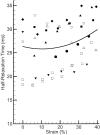
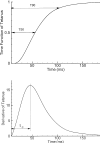

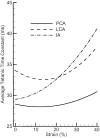
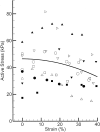
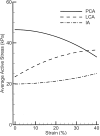
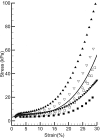

References
-
- Hirano M, Ohala J, Vennard W. The function of laryngeal muscles in regulating fundamental frequency and intensity of phonation. J Speech Hear Res. 1969;12:616–628. - PubMed
-
- Hirose H. Posterior cricoarytenoid as a speech muscle. Ann Otol Rhinol Laryngol. 1976;85:335–342. - PubMed
-
- Choi HS, Ye M, Berke GS. Function of the interarytenoid (IA) muscle in phonation: in vivo laryngeal model. Yonsei Med J. 1995;36:58–67. - PubMed
-
- Hillel AD. The study of laryngeal muscle activity in normal human subjects and in patients with laryngeal dystonia using multiple fine-wire electromyography. Laryngoscope. 2001;111(Suppl 97):1–47. - PubMed
-
- Farley GR. A biomechanical laryngeal model of voice F0 and glottal width control. J Acoust Soc Am. 1996;100:3794–3812. - PubMed
Publication types
MeSH terms
Grants and funding
LinkOut - more resources
Full Text Sources
Research Materials

